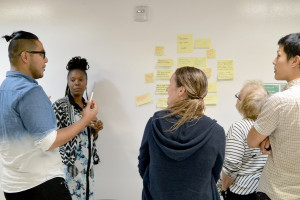Our Blog

Carnegie Mellon’s School of Design is proposing a new type of Designer, a new practice for working toward significant, complex issues: Transition Design. I think it’s especially relevant today because the current presidency is shining a light on so many social problems that are not on a healthy trajectory within the U.S. and this administration also manages to challenge any improvements to climate change and other environmental concerns.
In many ways, Transition Design builds on Service or Systems Design and Social Innovation. But what I’m fascinated by is that they aren’t taking the Human Centered Design tools that are familiar to us. They are proposing new tools, new mindsets, and new references to prepare students for truly wicked problems.
From the paper, “Transition Design Overview” by Irwin, Kossoff, and Tonkinwise,
“ The transition to sustainable futures calls for new ways of designing that are based upon a deep understanding of how to design for change and transition within complex systems (Irwin 2011). This knowledge and the new skillsets it will inform must be integrated from areas such as science, philosophy, psychology, social science, anthropology and the humanities and will therefore challenge existing design paradigms.”
https://www.academia.edu/13122242/Transition_Design_Overview
From Cameron Tonkinwise’s entertaining and challenging Medium post, “design thinking, yet again, because, maybe, it could actually be useful, perhaps even necessary, given every thing”
“We are not adequately seeing all these sociotechnical systems. We are missing the designed relations between these systems and our various habits and values that are proving so resistant to change toward more sustainable futures.”
https://medium.com/@camerontw/design-thinking-yet-again
Terry Irwin, Gideon Kossoff, and Cameron Tonkinwise boldly propose that in order to make a dent in these intractable problems, Designers of the Future will need new skills, postures, and foundations apart from traditional design practice, such as:
- Choosing a theme-based career, to stay with problems over time and across disciplines. An avocation, not a vocation.
- Developing less through individual creativity, and more relational discovery (talking to people, learning from experts, pulling in multiple types of information).
- Fostering criticism and resistance. These are activists they are raising over there. Resist the zero-sum, capitalistic drivers.
- More academic learning about theories of change and philosophy of mindsets and belief systems.
- Visioning at significant, long-term levels: radical visions of 2020, 2050 and 2100—because these are the timelines needed to solve many of the wicked problems.
- Therefore, Learning to plan a long-term project. You will only be part of a relay race, not a sprint.
